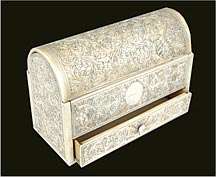The Islamic Arts Museum Malaysia (IAMM)
Part4
WOODWORK GALLERY View of Woodwork Gallery The Woodwork Gallery of the Islamic Arts Museum Malaysia displays a small, yet expanding collection of Islamic woodworks. Some of the fine examples of Islamic woodwork featured in the gallery are; pearl and tortoiseshell inlaid woodwork from Ottoman Turkey; the ivory inlaid woodwork of India and the delicate micro-mosaic woodwork ofPersia and Spain. Since the 16th and 17th centuries, the Ottoman and Safavid traditions had dominated the popular techniques employed in Islamic woodwork. The skills of Muslim craftsmen in carving and inlaying with materials such as mother of pearl, ivory, and tortoiseshell are renowned and highly appreciated. An extension of the woodwork gallery is devoted to a small collection of Iranian and Indian lacquer ware. Painted and lacquered decorations were introduced in Iran during the 18th century, these were mainly papier-mâché based book covers, pen cases, trays and mirrors etc. Most lacquer ware was decorated with miniature paintings or illuminations and coated with lustrous varnish.

Carved ivory casket
Sri Lanka. 17th century AD(Made for the Islamic market) Lacquered papier mache mirror case
Iran. 19th century AD Sandalwood box and cover (Qajar)
Iran, 19th century AD METALWORK GALLERY
View of Metalwork Gallery
The Metalwork gallery is an overview of the wide range of Islamic metalwork, which dates from the 7th to 20th centuries. The gallery, features a wide variety of the metalwork such as; vessels, utensils, candlesticks, tools and scientific instruments that aptly displays artistic developments in Islamic metalwork such as; calligraphic engravings, openwork, inlaid geometrical patterns and repousse. The collection also provides a comparison of the different forms and styles in metalwork design indigenous to the various Islamic provenance and dynasties.
Cloisonné Incense BurnerEgypt. c.1293 - 1341 ADMamluk brass candlestandEgypt. c.1293 - 1341 ADIslamic Coins
Abbassid. 750-1258 AD
An extension of the Metalwork Gallery features a collection of Islamic coins, such as this Abbassid coin from 750-1258 AD. Abbasid Coin design included the shahadah on the field, with the addition of the Mint place & Date as well as the Basmallah, inclined around the obverse margin. With the emergence of numerous dynasties, the Abbasid caliph's name was acknowledged as the religious leader of Islam and included within the reverse faces of coins.
Silver plated candle stand (Ottoman)Turkey. 1181 AH/1768 AD
THE STANDARD CHARTERED OTTOMAN ROOM View from Entrance of the Standard Chartered Ottoman Room
Sponsored by the Standard Chartered banking corporation, this room is a reconstructed interior of an Ottoman Syrian house which can be dated to 1235 AH (1820-21 AD) from an inscription on the ceiling panel. This sumptuously ornate room could have been found in the house of a rich merchant, a governor, or of the Azem palaces inHama andDamascus in Syria. The interior decoration informs us of the diversity of its origins. Syria itself had been a centre of political administration, religion, commerce and trading as well as urban culture for many centuries. Syria had been ruled over by the Greeks, theRoman Empire, the Byzantines, Mongols, Mamluks and the Ottomans.
Mihrab of the StandardChartered Ottoman Room
Wooden chandelier in theStandard Chartered Ottoman Room
CERAMICS AND GLASS GALLERY
The Ceramic and Glass gallery features a collection of artefacts ranging from; precious gold lustre ware bowls to colourful Iznik tiles of Ottoman Turkey. This gallery exhibits more than 130 ceramic and glass artefacts dating from as early as the 9th century. The ceramics and glass pieces on display are grouped according to provenance and style, these pieces were produced for different reasons such as; for domestic use, for export and for Royal commissions. The ceramic legacy left behind from the Byzantine and Sassanian period and the later deluge of Chinese porcelain imports from the Yuan and Ming Dynasty were absorbed and adapted by Muslim craftsmen to produce a highly decorative and innovative works of art uniquely identifying it as Islamic ceramic ware.
View of Ceramics & Glassware Gallery
16 Piece Earthenware Tile Set
Underglaze painted fritware dish (Ottoman)Iznik,Turkey. 16th century AD
Blue & white fritware dishIznik,Turkey. c. 1530 - 1535 AD